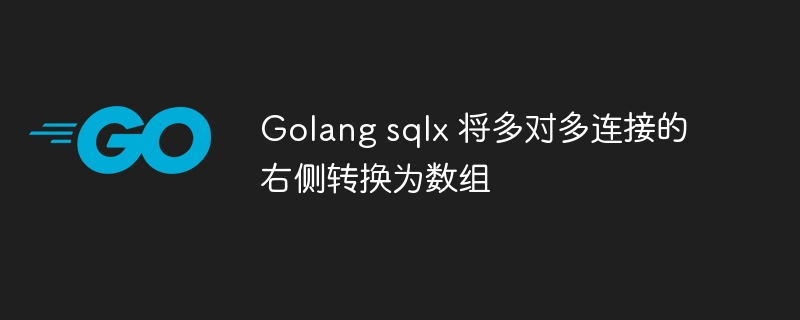Golang sqlx convert right side of many to many join to array
Feb 14, 2024 pm 02:48 PM
php Editor Xigua will introduce to you in this article how Golang sqlx converts the right side of a many-to-many connection into an array. Golang is a powerful programming language, and sqlx is a popular Golang database tool. When using sqlx for many-to-many connections, we often need to convert the results on the right side into an array for easier processing and operation. This article will introduce in detail how to use sqlx and some examples to demonstrate this process. I hope it will be helpful to everyone.
Question content
I have two tables unit and unitimage with unit foreign key.
I execute this sql query
select un.*, array_agg(row(ui.is_main, ui.image, ui.id)) as unit_images from unit un inner join unitimage ui on ui.unit_id = un.id group by un.id;
In response I got all the unit fields and joined the field unit_images like this
{"(f,photos/units/unit_37/90_big.jpg,108)","(f,photos/units/unit_37/91_big.jpg,109)","(f,photos/units/unit_37/92_big.jpg,110)","(f,photos/units/unit_37/93_big.jpg,111)"}go language structure
type unit struct {
id *int `json:"id" db:"id"`
name *string `json:"name" db:"name"`
... a lot of fields
unitimages []unitimages `json:"unit_images" db:"unit_images"`
}
type unitimages struct {
id *int `json:"id" db:"id"`
image *string `json:"image" db:"image"`
ismain *bool `json:"is_main" db:"is_main"`
}sqlxcode
query := fmt.Sprintf("SELECT un.*, array_agg(ROW(ui.id, ui.image, ui.is_main)) as unit_images FROM %s un INNER JOIN %s ui ON ui.unit_id = un.id GROUP BY un.id", unitsTable, unitImagesTable) err := r.db.Select(&units, query)
I got the error"sql: Scan error on column index 45, name \"unit_images\": Scan not supported, storing driver.value of type []uint8 to type *[]*unitimages"
I am new to golang and I would like any tips on how to solve this problem. Maybe I chose the wrong way.
I would like to know the correct way to solve this problem.
Solution
It seems that the returned sql result is:
un.id | un.name | un.description | unit_images ------+---------+----------------+--------------------------------------------------------------------- 1 | unit a | description a | [(true, 'image1.jpg', 1), (false, 'image2.jpg', 2), (false, 'image3.jpg', 3)] 2 | unit b | description b | [(true, 'image4.jpg', 4), (true, 'image5.jpg', 5), (false, 'image6.jpg', 6)] 3 | unit c | description c | [(true, 'image7.jpg', 7), (false, 'image8.jpg', 8), (false, 'image9.jpg', 9)]
so
`unitimages []unitimages `json:"unit_images" db:"unit_images"`
This is the correct idea, you have a unitimages array. but:
id *int `json:"id" db:"id"`
image *string `json:"image" db:"image"`
ismain *bool `json:"is_main" db:"is_main"`Please note that id, image, is_main do not have sql columns, so go cannot map them.
Easy fix change unitimages to []any and then cast the contents into that array yourself like this:
for _, item := range thing.UnitImages {
isMain := item[0].(bool)
image := item[1].(string)
id := item[2].(int64)
//TODO do something with these vars
}
Or you could use `pg.StringArray` type.The above is the detailed content of Golang sqlx convert right side of many to many join to array. For more information, please follow other related articles on the PHP Chinese website!

Hot Article

Hot tools Tags

Hot Article

Hot Article Tags

Notepad++7.3.1
Easy-to-use and free code editor

SublimeText3 Chinese version
Chinese version, very easy to use

Zend Studio 13.0.1
Powerful PHP integrated development environment

Dreamweaver CS6
Visual web development tools

SublimeText3 Mac version
God-level code editing software (SublimeText3)

Hot Topics
 Go language pack import: What is the difference between underscore and without underscore?
Mar 03, 2025 pm 05:17 PM
Go language pack import: What is the difference between underscore and without underscore?
Mar 03, 2025 pm 05:17 PM
Go language pack import: What is the difference between underscore and without underscore?
 How to implement short-term information transfer between pages in the Beego framework?
Mar 03, 2025 pm 05:22 PM
How to implement short-term information transfer between pages in the Beego framework?
Mar 03, 2025 pm 05:22 PM
How to implement short-term information transfer between pages in the Beego framework?
 How do I write mock objects and stubs for testing in Go?
Mar 10, 2025 pm 05:38 PM
How do I write mock objects and stubs for testing in Go?
Mar 10, 2025 pm 05:38 PM
How do I write mock objects and stubs for testing in Go?
 How can I use tracing tools to understand the execution flow of my Go applications?
Mar 10, 2025 pm 05:36 PM
How can I use tracing tools to understand the execution flow of my Go applications?
Mar 10, 2025 pm 05:36 PM
How can I use tracing tools to understand the execution flow of my Go applications?
 How can I define custom type constraints for generics in Go?
Mar 10, 2025 pm 03:20 PM
How can I define custom type constraints for generics in Go?
Mar 10, 2025 pm 03:20 PM
How can I define custom type constraints for generics in Go?
 How to write files in Go language conveniently?
Mar 03, 2025 pm 05:15 PM
How to write files in Go language conveniently?
Mar 03, 2025 pm 05:15 PM
How to write files in Go language conveniently?
 How to convert MySQL query result List into a custom structure slice in Go language?
Mar 03, 2025 pm 05:18 PM
How to convert MySQL query result List into a custom structure slice in Go language?
Mar 03, 2025 pm 05:18 PM
How to convert MySQL query result List into a custom structure slice in Go language?
 How do I write benchmarks that accurately reflect real-world performance in Go?
Mar 10, 2025 pm 05:36 PM
How do I write benchmarks that accurately reflect real-world performance in Go?
Mar 10, 2025 pm 05:36 PM
How do I write benchmarks that accurately reflect real-world performance in Go?







